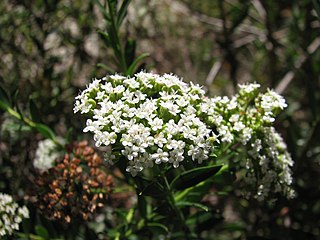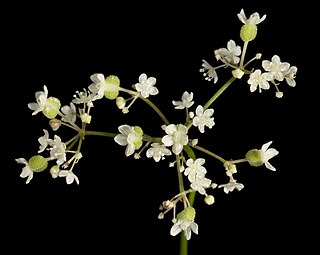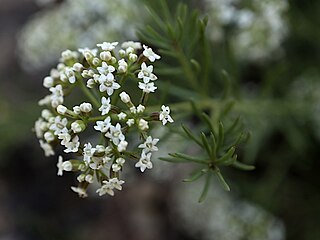
Banksia drummondii, commonly known as Drummond's dryandra, is a species of shrub that is endemic to Western Australia. It has pinnatifid to pinnatisect leaves, heads of up to one hundred cream-coloured, red and yellow flowers and glabrous fruit.

Platysace is a genus of about 22 species of woody perennial herbs, shrubs and subshrubs in the family Apiaceae, and is endemic to Australia. The flowers are borne on the ends of branches in a compound umbel and are bisexual or male with white, cream-coloured or pinkish flowers.

Grevillea umbellulata is species of flowering plant in the family Proteaceae and is endemic to the south-west of Western Australia. It is a spreading shrub that forms a lignotuber, has linear to narrowly elliptic leaves, and cylindrical clusters of hairy, white to cream-coloured flowers often tinged with grey or pink.

Grevillea paniculata, commonly known as kerosene bush, is a species of flowering plant in the family Proteaceae and is endemic to the south-west of Western Australia. It is a dense shrub with divided leaves, the lobes linear, and more or less spherical clusters of white to cream-coloured flowers.

Grevillea drummondii, commonly known as Drummond's grevillea, is a species of flowering plant in the family Proteaceae and is endemic to the south-west of Western Australia. It is a low, spreading to erect shrub with narrowly elliptic to narrowly egg-shaped leaves with the narrower end towards the base, and dense groups of cream-coloured flowers that turn pink or red as they age.

Grevillea diversifolia, the variable-leaved grevillea, is a species of flowering plant in the family Proteaceae and is endemic to the south-west of Western Australia. It is an erect to prostrate shrub with simple or divided leaves and groups white to cream-coloured flowers with a dull red style.

Grevillea pulchella, commonly known as beautiful grevillea, is a species of flowering plant in the family Proteaceae and is endemic to the southwest of Western Australia. It is a spreading shrub usually with pinnatisect leaves, and cylindrical clusters of white to cream-coloured flowers.

Grevillea candolleana, commonly known as the Toodyay grevillea, is a species of flowering plant in the family Proteaceae and is endemic to a restricted part of the south-west of Western Australia. It is a shrub with narrow egg-shaped to linear leaves and white to cream-coloured flowers.

Grevillea scabra, commonly known as the rough-leaved grevillea, is a species of flowering plant in the family Proteaceae and is endemic to the south-west of Western Australia. It is a low, open shrub with clusters of narrowly elliptic to more or less linear leaves and small clusters of white to cream-coloured flowers.

Grevillea trifida is species of flowering plant in the family Proteaceae and is endemic to the southwest of Western Australia. It is a spiny, erect to low spreading shrub, usually with divided, variably-shaped leaves, and clusters of white to cream-coloured flowers.
Platysace cirrosa, commonly known as karna, is a twining, perennial herb or climber that is endemic to the south-west of Western Australia. The Noongar name for the plant is kanna. It is leafless, sometimes with a few very small scale-like leaves, and flowers arranged in umbels with overlapping yellow petals and flattened fruit.

Platysace commutata is a shrub that is endemic to the south-west of Western Australia. It has linear leaves and white to cream-coloured or blue flowers.

Platysace compressa, commonly known as tapeworm plant, is endemic to the south-west of Western Australia. It is an erect, ascending or low-lying perennial herb, sometimes with no leaves, or leaves reduced to scales, on flat, winged stems.

Platysace deflexa, known by its Noongar name youlk or as Ravensthorpe radish, is a species of flowering plant in the family Apiaceae and is endemic to the south-west of Western Australia. It is a tuberous, perennial herb or shrub with linear leaves and white flowers in a compound umbel.

Hibbertia montana is a species of flowering plant in the family Dilleniaceae and is endemic to the south-west of Western Australia. It is an erect, straggling or sprawling shrub with densely hairy foliage, narrow oblong leaves, and pedunculate yellow flowers with thirty to sixty stamens and a few staminodes arranged around velvety carpels.
Lasiopetalum indutum is a species of flowering plant in the family Malvaceae and is endemic to the south-west of Western Australia. It is an erect or straggling shrub with hairy stems and pink, cream-coloured or white flowers.
Thomasia discolor is a species of flowering plant in the family Malvaceae and is endemic to the south-west of Western Australia. It is a small, compact shrub with hairy new growth, heart-shaped leaves with wavy, lobed edges, and pink flowers in crowded clusters.
Cryptandra nutans is a species of flowering plant in the family Rhamnaceae and is endemic to the southwest of Western Australia. It is a shrub that typically grows to a height of 10–60 cm (3.9–23.6 in) and has many stems at ground level. Its leaves are up to 4 mm (0.16 in) long, and the flowers are white, pink or cream-coloured and crowded in spikes on the ends of branches. The sepals are joined at the base to form a broadly bell-shaped tube, less than 2 mm (0.079 in) long with spreading lobes. Flowering occurs in August and September. It was first formally described in 1845 by Ernst Gottlieb von Steudel in Lehmann's Plantae Preissianae from specimens collected in 1840. The specific epithet (nutans) means "nodding".

Platysace effusa is a species of flowering plant in the family Apiaceae and is endemic to the south-west of Western Australia. It is a tuberous, perennial herb or shrub with linear leaves and white flowers in a compound umbel.

Platysace ericoides, commonly known as heath platysace, is a species of flowering plant in the family Apiaceae and is endemic to eastern Australia. It is a semi-prostrate to weakly erect, open shrub or subshrub with linear or elliptic to oblong leaves with white or cream-coloured flowers in compound umbels with 3 to 10 rays.
















